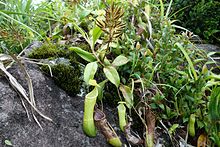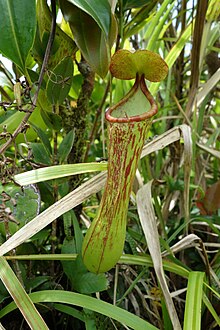
Nepenthes truncata is a tropical pitcher plant endemic to the Philippines. It is known from the islands of Dinagat, Leyte, and Mindanao. The species grows at an elevation of 0–1500 m above sea level. Nepenthes truncata is characterised by its heart-shaped (truncate) leaves and very large pitchers, which can reach up to 40 cm in height.

Nepenthes alata is a tropical pitcher plant endemic to the Philippines. Like all pitcher plants, it is carnivorous and uses its nectar to attract insects that drown in the pitcher and are digested by the plant. It is highly polymorphic, and its taxonomy continues to be subject to revisions.
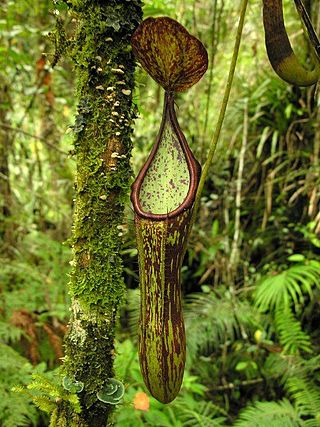
Nepenthes copelandii is a species of pitcher plant native to the island of Mindanao in the Philippines. Originally known from Mount Apo near Davao City and Mount Pasian near Bislig, it has since been discovered on a number of peaks throughout Mindanao. It may also be present on the nearby island of Camiguin. The species has a wide altitudinal distribution of 1100–2400 m above sea level. Nepenthes copelandii has no known natural hybrids. No forms or varieties have been described.
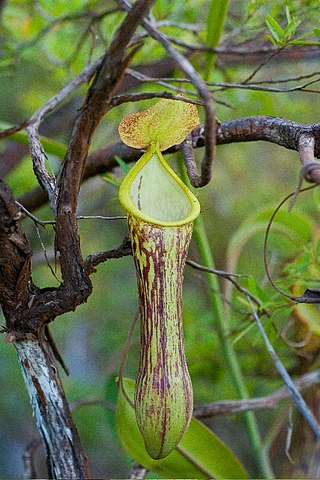
Nepenthes mindanaoensis is a tropical pitcher plant native to the Philippine islands of Mindanao and Dinagat.
Nepenthes saranganiensis is a tropical pitcher plant native to the Philippine island of Mindanao. It is noted for its extremely decurrent leaf attachment that extends a large distance down the stem, often continuing into the next internode.
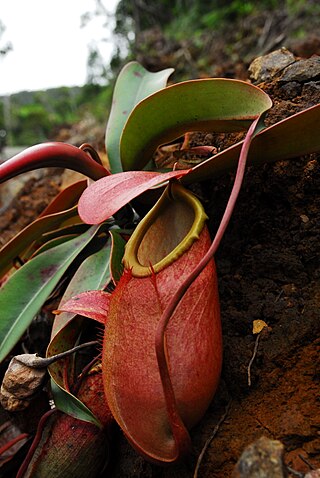
Nepenthes merrilliana is a tropical pitcher plant endemic to the Philippines. It produces some of the largest pitchers in the genus, rivalling those of N. rajah.

Nepenthes petiolata is a highland Nepenthes pitcher plant species endemic to Mindanao island in the Philippines, where it grows at an elevation of 1,450–1,900 metres (4,800–6,200 ft) above sea level.

Nepenthes graciliflora is a tropical pitcher plant endemic to the Philippines. Long considered a synonym of N. alata, it was restored as a separate species in 2013 by Martin Cheek and Matthew Jebb. It has been recorded from the islands of Bohol, Leyte, Luzon, Mindanao, Mindoro, Panay, Samar, and Sibuyan, and following the redelimitation of N. alata is the most widespread Nepenthes species of the Philippines. It is known from mossy, submontane forest, generally at 800–1,280 metres (3,000–4,000 ft) altitude, though the type specimen from Sibuyan was collected at only 300 m (1,000 ft).

Nepenthes micramphora is a tropical pitcher plant known only from Mount Hamiguitan on the island of Mindanao in the Philippines. It is a highland plant growing at elevations of 1100–1635 m.
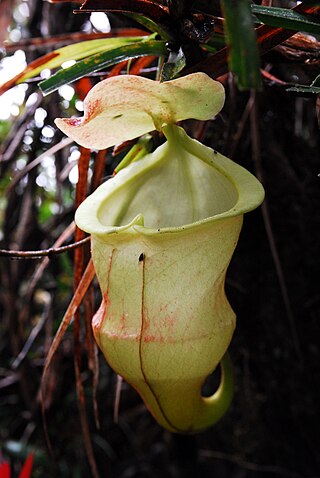
Nepenthes hamiguitanensis is a tropical pitcher plant endemic to a single peak on the Philippine island of Mindanao, where it grows at elevations of 1200–1600 m above sea level. Once thought to be a natural hybrid between N. micramphora and N. peltata, this plant is now considered a species of possible hybridogenic origin. It produces squat upper pitchers that vary greatly in pigmentation, from red speckled to yellow throughout.

Nepenthes ceciliae is a tropical pitcher plant endemic to the Philippine island of Mindanao, where it grows at 1500–1880 m above sea level. Its discovery was announced online in August 2011.
Nepenthes negros is a tropical pitcher plant native to the Philippines, specifically the islands of Biliran and Negros.
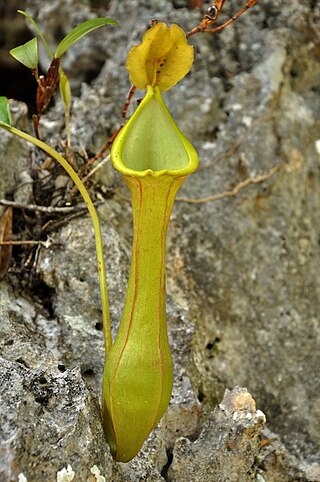
Nepenthes viridis is a tropical pitcher plant endemic to the Philippines. It is known only from coastal areas at low altitude and has been recorded from Dinagat, Samar, and a number of surrounding islets. It is closely allied to the N. alata group of species.

Nepenthes extincta is a tropical pitcher plant native to the Philippines. It is known only from Surigao del Sur, Mindanao, where it has been recorded at c. 400 metres (1,300 ft) altitude.
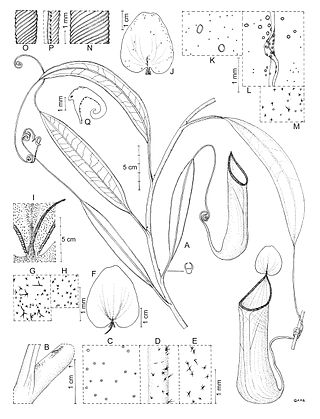
Nepenthes leyte is a tropical pitcher plant native to the Philippines. It appears to be endemic to the island of Leyte, after which it is named. It has been recorded from submontane mossy forest at 900 m altitude.

Nepenthes cornuta is a tropical pitcher plant native to the Philippines. It is known only from the Pantaron Mountain Range of central Mindanao, where it grows terrestrially on ultramafic soils at around 1000 m above sea level.

Nepenthes talaandig is a tropical pitcher plant native to the Philippines. It is known only from the Pantaron Mountain Range of central Mindanao, where it grows terrestrially on ultramafic soils at around 1000 m above sea level.
